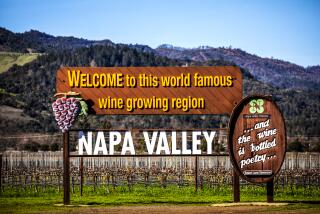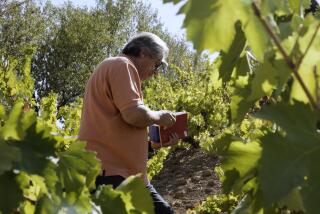Treading Historic Alsace Wine Path
ROUFACH, France — It’s a wine route of poetry and always the unexpected, from the seven grapes of the Alsace vineyards to legendary castles, flower-decked villages and the birthplace of Albert Schweitzer.
Of all the wine routes in Europe, this is one of the least known to travelers from the United States, and yet one of the most bewitching in its setting and story.
As we sit by the window of our room in a “Sleeping Beauty” chateau that has its own vineyards and remains of medieval fortifications, we can see the Wine Route of Alsace-Lorraine winding along the French side of the River Rhine, beneath the slopes of the Vosges mountain range.
Looking out over the spires and towers of the Middle Ages in the village of Roufach, the hills of the Black Forest on the West German side of the Rhine roll south in waves of woodlands to the Swiss Alps.
The Alsace vineyards rise above and around more than 50 villages for nearly 100 miles between Thann and Strasbourg. Three Sundays ago I wrote of our visit to Colmar.
Sleeping Beauty Chateau
We went on from Colmar to drive the Wine Route and walk its footpaths from our romantic base here in Roufach at Chateau d’Isenbourg. The chateau is said by a chronicler to have come back to life like a sleeping beauty from a storied past that began as a castle for Merovingian kings before the 7th Century.
For earlier centuries, the strategic Isenbourg site was on a military and commercial high road of the Roman Empire. There are also evidences that people of the Stone, Bronze and Iron ages defended their settlements here.
In AD 662 a charter was signed at Chateau d’Isenbourg by which King Dagobert II granted the stately property that had been his residence to the Bishop of Strasbourg in gratitude for what he considered the miraculous healing of his son who was wounded while hunting wild boar. Charlemagne stayed at the chateau in the year 800. Emperor Maximilian occupied a suite in 1511.
Rose of Roufach
In the year 1106 the women of Roufach made history by taking up arms in a surprise attack on the chateau to save a beautiful young girl, forever to be known as the Rose of Roufach, who was abducted on her way to Mass at the Church of Notre Dame by an officer of the Royal Guard.
Rebuilt and ravaged many times over the centuries, occupied by German officers during World War II, the chateau has awakened again as a regal guest hotel with 40 suites and apartments, high above the medieval village and the hillside verdant with its own vineyards, complemented by a late 20th-Century swimming pool and tennis court in the garden.
For 11 years the Sonets family has guided its refurbishment, and Daniel Dalibert is the managing director you’re sure to meet soon after arriving. The two chambers of the elegant restaurant in the old vaulted cellars date from the 15th and 16th centuries. In the larger Caveau des Princes Eveques are traces of decorative work undertaken by Bishop Conrad of Lichtenberg in AD 1228.
The original Romanesque design of the Parish Church dedicated to Our Lady of Assumption reflects the evolution of architecture from the 12th to the 19th centuries. It is set in a medieval townscape that includes the Town Hall begun in the 16th Century, and the Witch Tower and the house with the vaulted cellar where the Inquisition sat in the 16th and 17th centuries. Beside the cobbled streets are the patrician homes built by early wine growers.
The Seven Grapes of Alsace produce great wines of France in the vineyards all along this winding Wine Route. Reisling, fruity and with a delicate bouquet, is considered “the triumph of Alsace.” It is complemented by the light and fresh Sylvaner, the elegant bouquet of Gewurztraminer, the tender flavor of Muscat, the freshness of Tokay Pinot Gris, the full-bodied Pinot Blanc and the delicious fruitiness of Pinot Noir.
‘Secret Alsace’
Wine lovers of the region told us that the “secret Alsace” is to be discovered along eight walking paths through the heart of the vineyards, where the individuality and fragrance of the grapes close in around you. Each is a walk of about two hours, with tastings as temptations along the way. Signs along the paths describe the various vines, and tell you what the grower is doing to help the magic of nature.
The eight paths leave from the villages of Turckheim, Dambach-la-Ville, Pfaffenheim, Marienheim, Obernai, Epfig, Traenheim and Bergheimwind. When you learn to pronounce the names, they make their own blank verse poetry.
They also tell of the history of Alsace under French and German flags. In 1871, following the Franco-Prussian War, Alsace was annexed to the German Empire and remained so until the Treaty of Versailles after World War I restored the region to France.
U.S. forces helped liberate Alsace from Nazi occupation during World War II, and the Colmar Pocket was the center of the crucial Allied effort. The people today tend not only to be bilingual in French and German but likewise to prefer their own dialect and often demonstrate the linguistic versatility of welcoming visitors in English. There is warm friendship for Americans.
Albert Schweitzer Museum
Nothing along the Wine Route, however, entirely prepared us for the surprise of Kaysersberg as the birthplace of Dr. Albert Schweitzer. He was born here on Jan. 1, 1875. His bronze bust stands on a pedestal in a small park beside the Cultural Museum honoring the man who received the Nobel Peace Prize in 1954.
The story of his life is poignantly relived in this small museum, his work in music, his studies in theology and then in medicine, his founding with his wife Helene of the Lambarene hospital for the poor and the homeless in Gabon, Africa, just before World War I.
Photos show how he devoted many years of his life to working at Lambarene, and yet also found time to write of his philosophical and theological concerns for peace in the atomic age, and to play organ recitals in Europe about the Apostle Paul.
The glow of life along the Alsace Wine Route had a new wonder about it when we stepped out of the museum. We were in no hurry to leave Kaysersberg, its twin-gabled Gothic houses, the Renaissance Town Hall and the church begun in the 12th Century.
Not far from Kaysersberg is Chateau Koenigsburg, a fairy-tale kind of 12th-Century castle on a misty hilltop. It was restored by Kaiser Wilhelm II when Alsace was part of Germany. The village of Zellenberg on a hillside that a local writer calls “a waving sea of vines” was fortified in AD 1252 and now peacefully overlooks the entire Alsace plain.
The Alsace Wine Museum in the castle at Kientzheim tells the story of wine making since the 15th Century. The tourist office in Roufach, and the Center of Information of the Wine Country of Alsace in Colmar, will introduce you to more stops along the Wine Route than you could possibly make in any one visit, and also to places to stay within all budget ranges. There are also many camping places.
Musical concerts on Saturday evenings in the vaulted cellars of Chateau d’Isenbourg are mellow mood-setters for the Wine Route of Alsace. A suite with breakfast here is about $100, and reservations can be made through your travel agent. For guidance in preparing for this Wine Route, contact the French Government Tourist Office at 9401 Wilshire Blvd., Los Angeles 90211, phone (213) 272-2661.
More to Read
Sign up for The Wild
We’ll help you find the best places to hike, bike and run, as well as the perfect silent spots for meditation and yoga.
You may occasionally receive promotional content from the Los Angeles Times.






